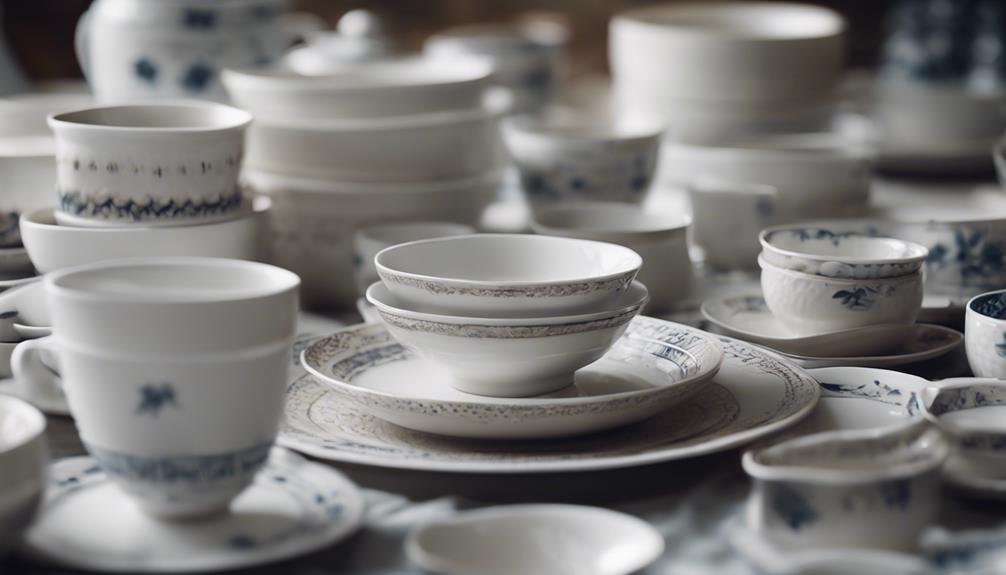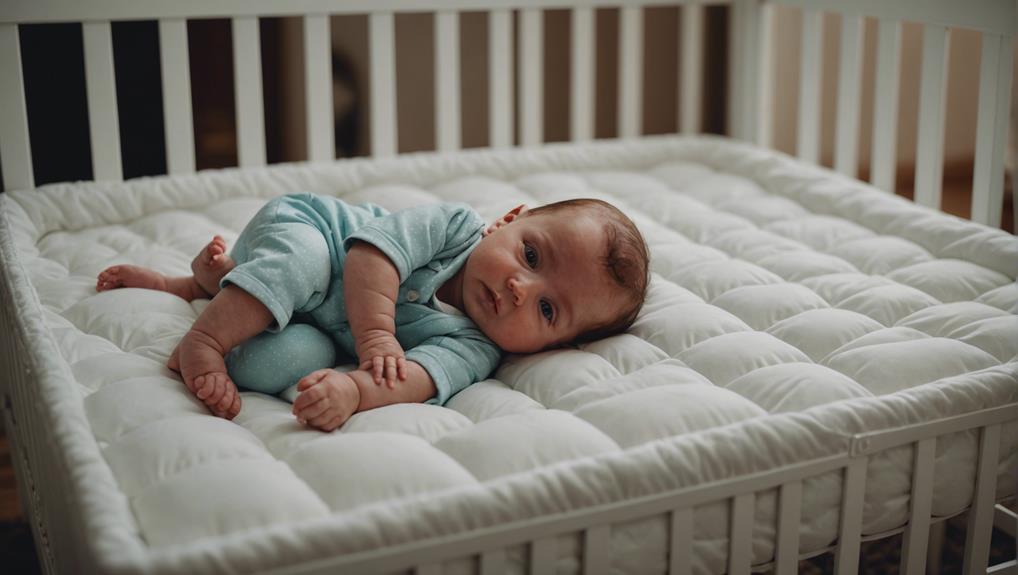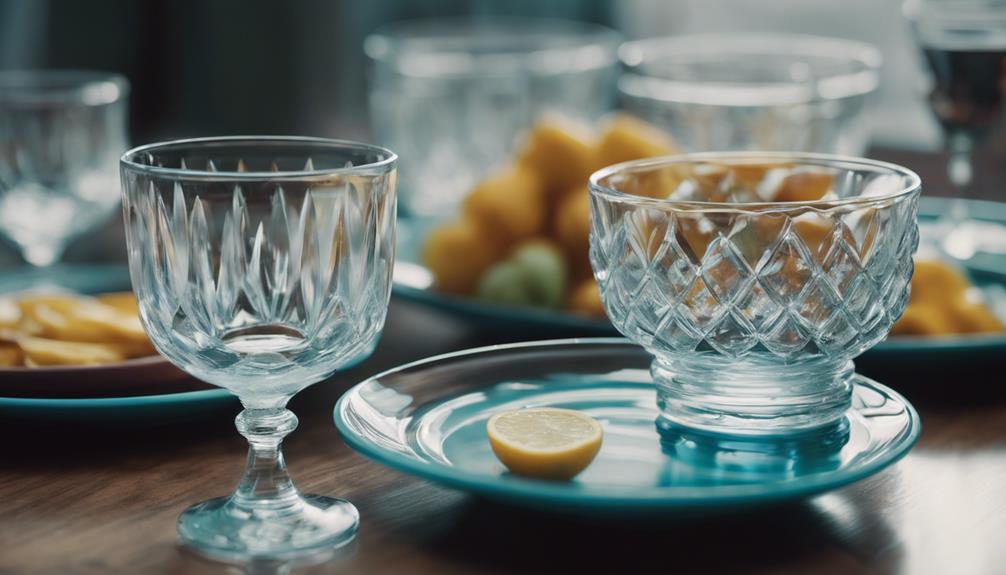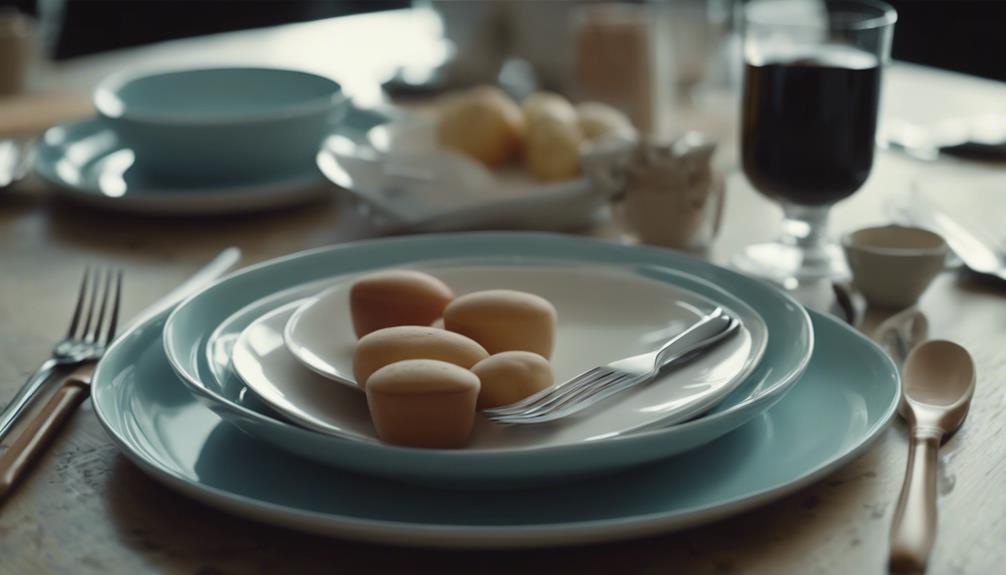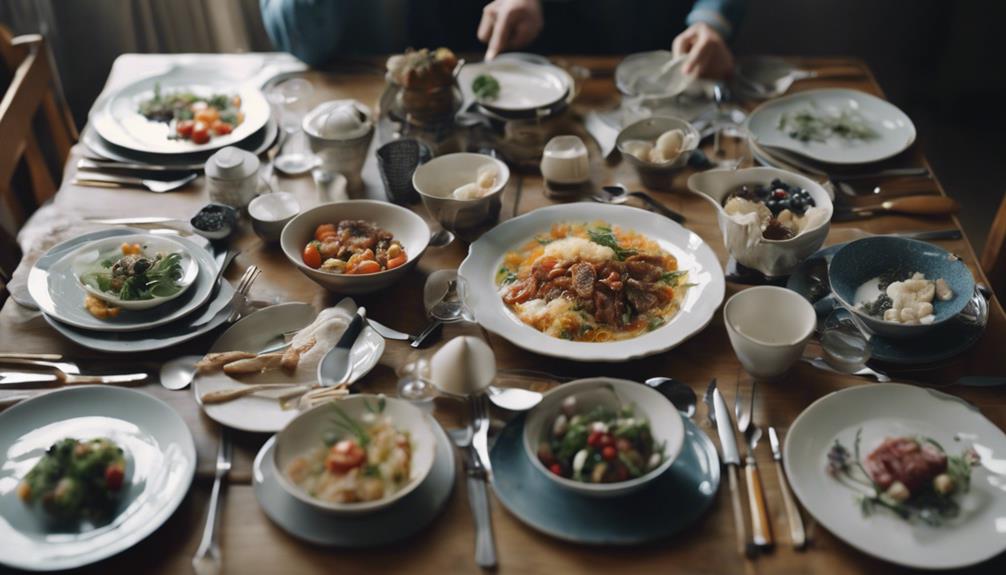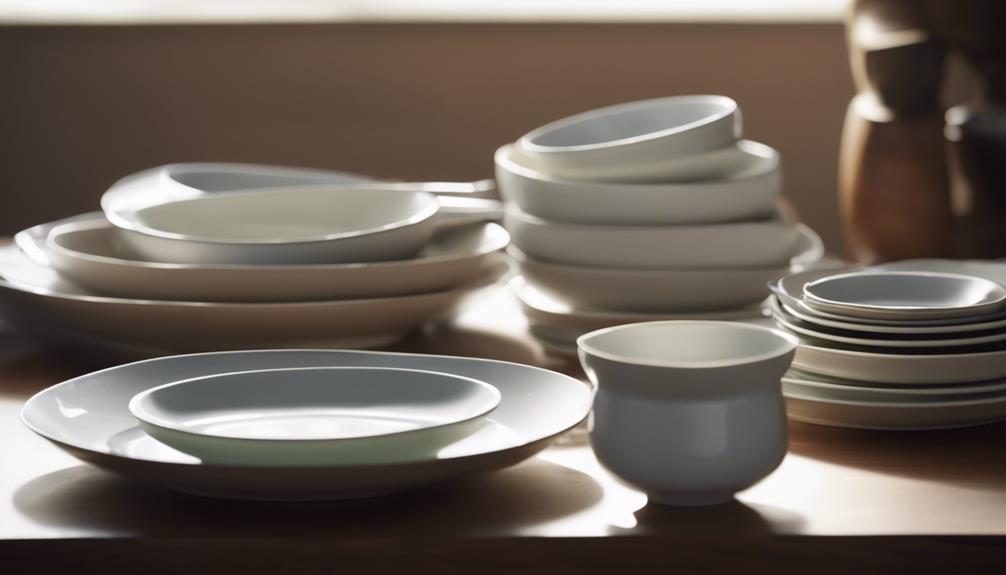Porcelain tableware, renowned for its high firing temperatures, elegant white appearance, and durability, is a classy option for your dining needs. With its non-porous nature, resistance to stains and odors, porcelain ensures easy upkeep. The even heat distribution qualities of porcelain make it perfect for baking and serving food. This versatile material is safe to use in the microwave, oven, freezer, and dishwasher. Whether for everyday meals or special occasions, porcelain tableware brings a touch of sophistication to your table setting. Learn more about the advantages and various types of porcelain tableware to enhance your dining experience.
Key Takeaways
- Porcelain tableware is durable, non-porous, and stain-resistant.
- It offers an elegant and refined appearance in classic white.
- Suitable for formal dining occasions due to its luxurious finish.
- Versatile for everyday use, safe for microwave, oven, and dishwasher.
- Crafted from refined clay and bone ash for durability and sophistication.
Properties of Porcelain Tableware
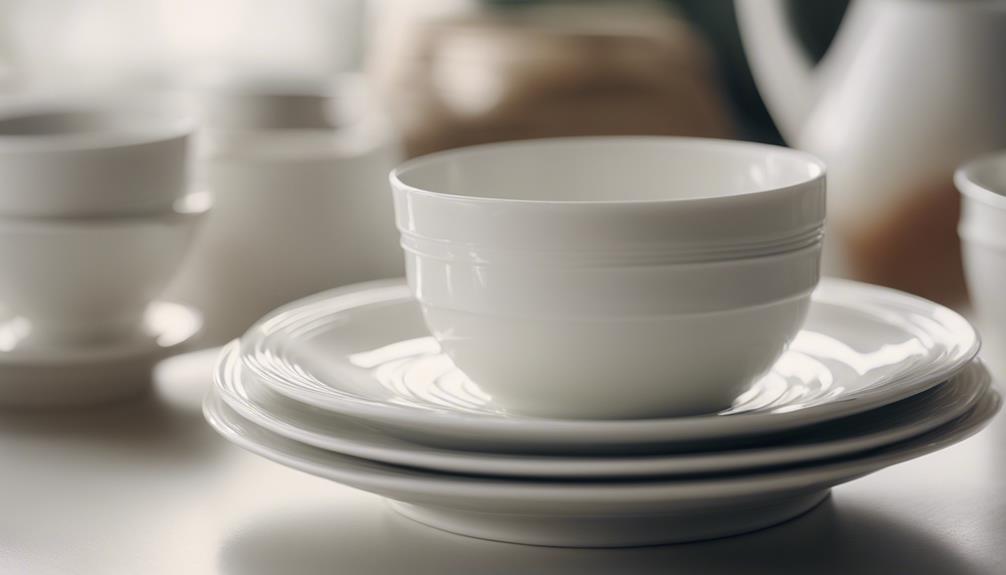
When considering porcelain tableware, you'll find it boasts unique properties that set it apart from other types of tableware. Porcelain is a type of ceramic that undergoes high firing temperatures, resulting in a durable and chip-resistant material. One of its standout features is that it's non-porous, making it highly resistant to stains and odors. This quality not only guarantees that your tableware remains pristine but also makes it easier to clean and maintain over time.
The elegant and refined appearance of porcelain tableware makes it a popular choice for formal dining occasions. Its classic white color adds a touch of sophistication to any table setting, creating a timeless aesthetic. Additionally, porcelain's even heat distribution properties make it ideal for baking and serving food.
Benefits of Using Porcelain Tableware
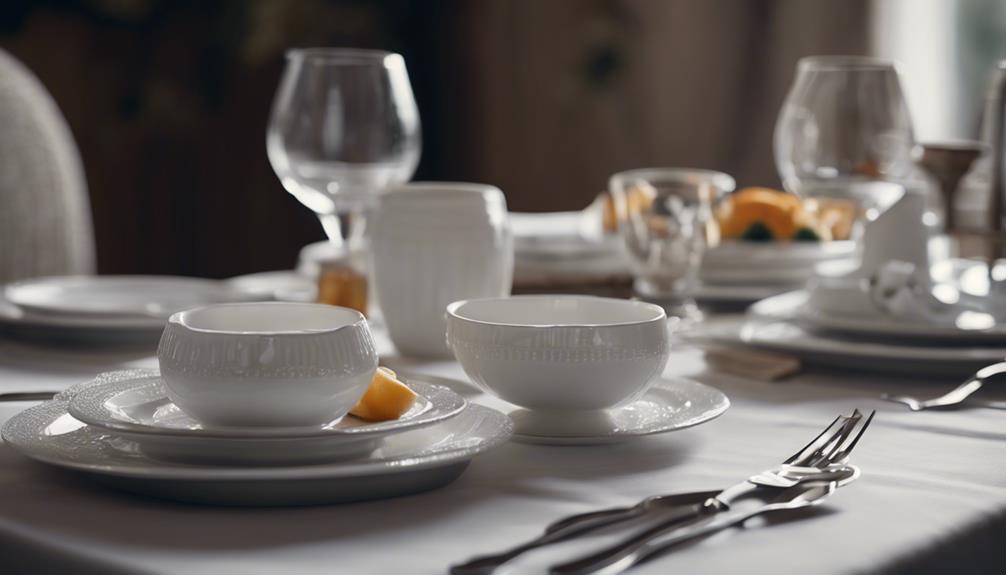
Looking into the advantages of using porcelain tableware, you'll discover a range of benefits that elevate your dining experience. Porcelain tableware is highly durable, making it perfect for everyday meals or special occasions as it's resistant to chipping. Its non-porous quality not only adds to its durability but also makes it stain-resistant, allowing for easy cleaning and maintaining a pristine look.
The versatility of porcelain tableware is unmatched, being safe for use in microwaves, ovens, freezers, and dishwashers, providing convenience in various cooking and serving scenarios. Additionally, the elegant and refined appearance of porcelain tableware adds a touch of sophistication to your table setting, perfect for formal dining environments.
Crafted from refined clay and materials like bone ash, porcelain tableware's luxurious white finish brings a sense of opulence to your dining experience.
Manufacturing Process of Porcelain Tableware
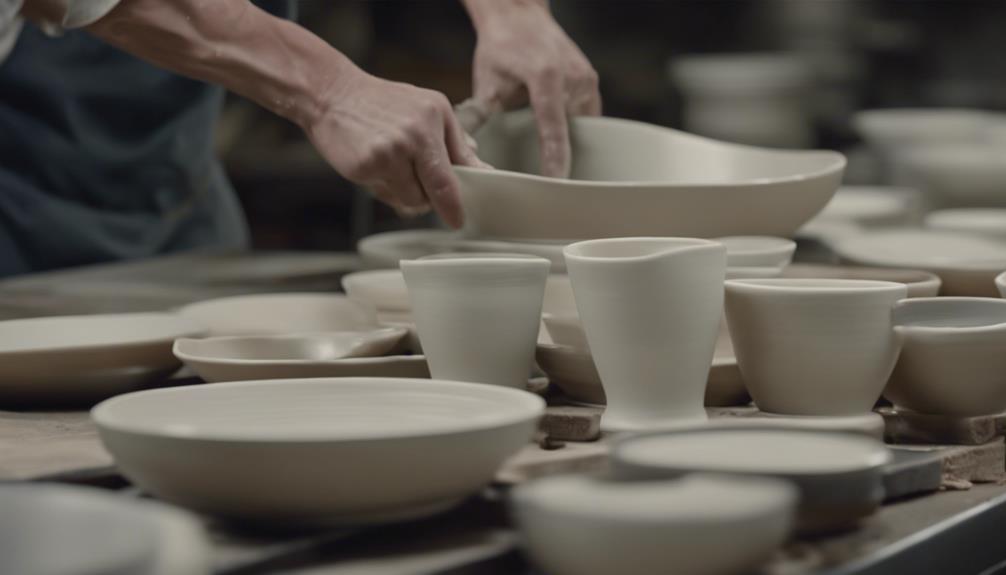
Porcelain tableware undergoes a meticulous manufacturing process involving a blend of clay, kaolin, feldspar, and quartz. The clay is mixed with these materials to create a smooth and durable porcelain mixture. This mixture is then shaped into the desired tableware forms, such as plates, bowls, or cups. The next vital step in the manufacturing process is firing the shaped porcelain at high temperatures ranging from 1,200 to 1,400 degrees Celsius. This high firing temperature is essential for the porcelain to achieve its dense and non-porous quality, making it ideal for various dining settings.
Bone china, a specific type of porcelain, is fortified by incorporating bone ash into the clay mixture. This addition enhances the strength and resilience of the porcelain, resulting in an off-white material known for its durability and elegance. The manufacturing process of porcelain tableware ensures that each piece is crafted to withstand everyday use while maintaining a sophisticated appearance.
Different Types of Porcelain Tableware
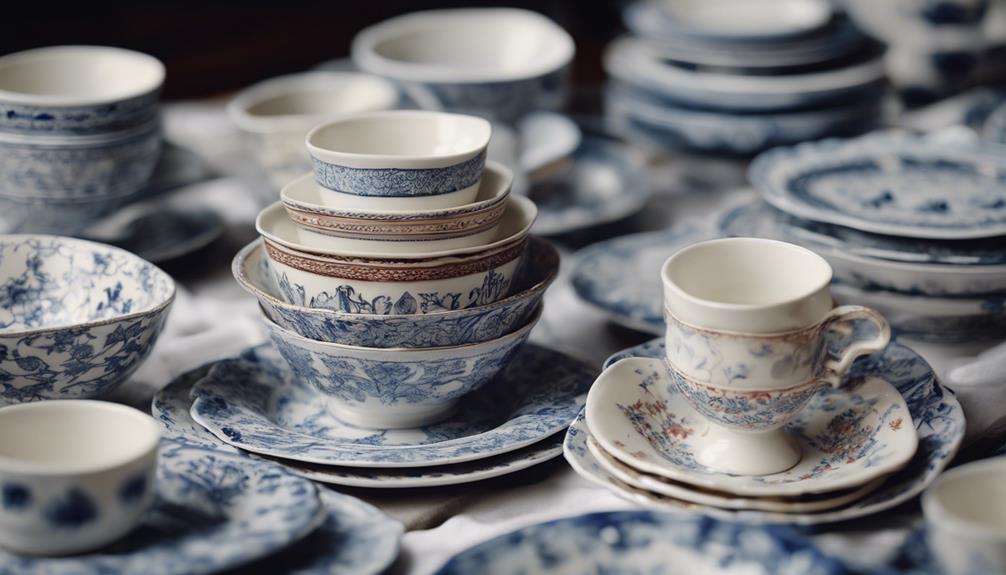
Exploring the world of fine dining, you'll find a diverse array of porcelain tableware that caters to various tastes and occasions. Porcelain tableware, known for its durability and elegant appearance, comes in different types to suit different needs. One popular type is bone china, which includes bone ash in its clay mixture for extra strength and a bright white color. This type of porcelain tableware is fired at high temperatures, typically between 1,200-1,400 degrees Celsius, to achieve its density and strength. Its non-porous surface makes it ideal for formal dining, as it resists stains and scratches, maintaining its luxurious look. Below is a table highlighting some key types of porcelain tableware:
| Type | Description | Features |
|---|---|---|
| Bone China | Contains bone ash for strength and color | High temperature firing, formal dining |
| Fine Porcelain | Refined clay, feldspar, and quartz mixture | Non-porous, elegant appearance |
History of Porcelain Tableware
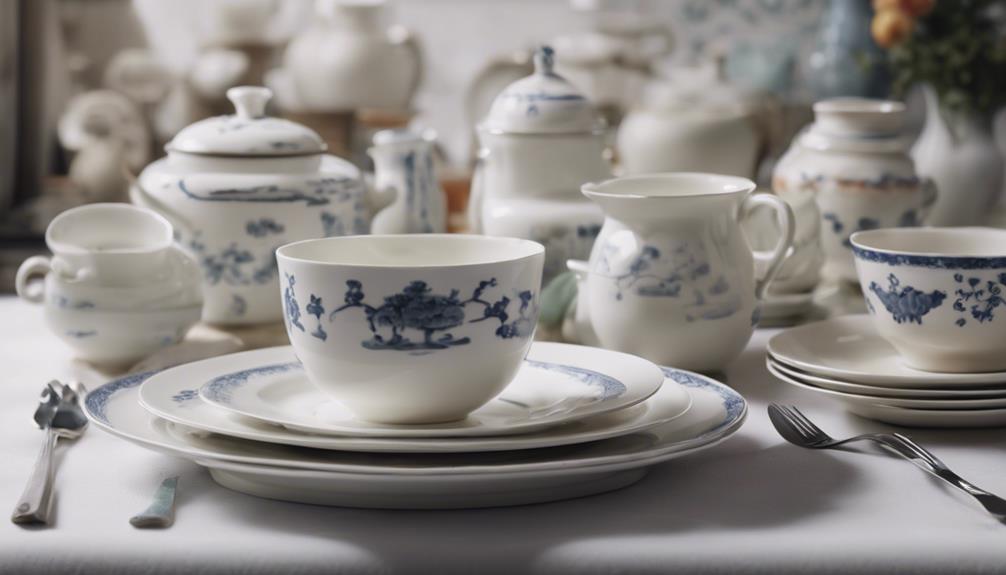
With origins tracing back to ancient China, the history of porcelain tableware is steeped in elegance and tradition. Porcelain dinnerware is a type of ceramic made from refined clay that's fired at high temperatures, resulting in durable and non-porous pieces.
Dating back to ancient times, porcelain tableware was first developed in China and later became highly prized in Europe during the 18th century, igniting a craze for porcelain table settings. Known for its luxurious appearance, porcelain tableware is a popular choice for formal dining occasions due to its elegant and sophisticated look.
The production process of porcelain involves firing at high temperatures, ensuring its resilience and longevity. Often hand-painted or adorned with intricate designs, porcelain tableware not only adds to its aesthetic appeal but also increases its value, making it a coveted choice for those seeking elegance and beauty in their dining experience.
Porcelain Vs Other Types of Tableware
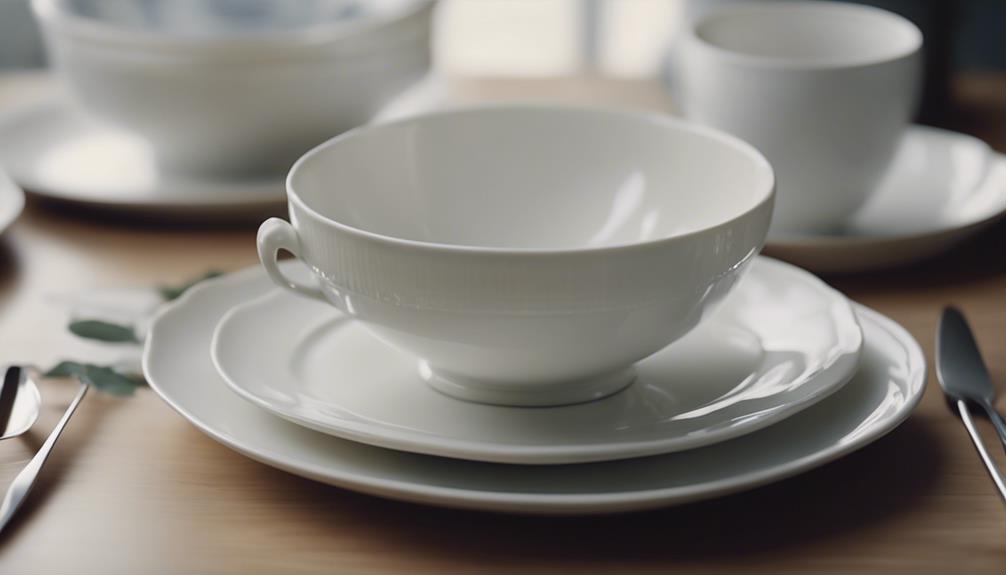
When considering tableware options, you'll notice that porcelain stands out for its durability and luxurious appearance compared to ceramic or earthenware choices. Porcelain, made from clay, is fired at a higher temperature than other types of ceramic, resulting in a denser and less porous material. This makes porcelain tableware more durable and resistant to stains, ideal for both formal occasions and everyday use. In contrast, ceramic and earthenware options are more porous and prone to chipping or staining.
Porcelain tableware is often associated with luxury due to its high-quality finish and elegant appearance. The production process of porcelain involves firing at high temperatures, which creates a strong and durable final product. This durability makes porcelain tableware perfect for fine dining experiences and special occasions, where its exquisite and refined characteristics can truly shine. Overall, when choosing tableware, porcelain's durability and luxurious appeal set it apart from other types of ceramic and earthenware options.
Care and Maintenance of Porcelain Tableware
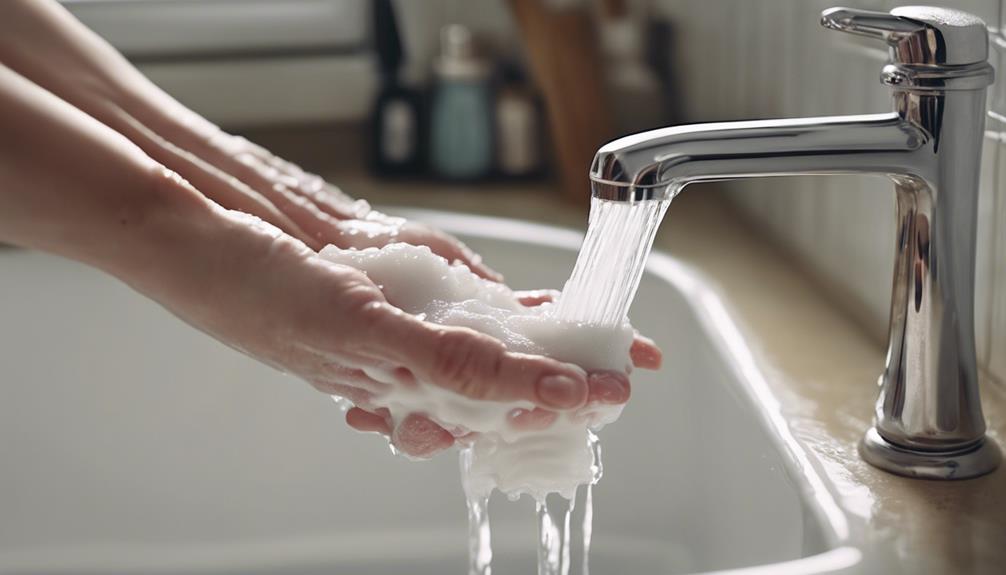
Porcelain tableware's luxurious appearance and durability are best preserved through proper care and maintenance techniques. Made from high-fired porcelain clay, this Ceramic Dinnerware is known for its non-porous nature, making it resistant to stains and easy to clean.
When cleaning your porcelain tableware, avoid abrasive cleaners that can scratch the surface. While dishwasher safe, hand washing with a mild detergent is recommended for long-lasting quality. Store your porcelain tableware with care, using soft padding or cloth in between pieces to prevent chipping or breakage.
Regularly inspect your tableware for any cracks or damage, as these can compromise the integrity of the pieces over time. By following these simple maintenance tips and handling your porcelain tableware with attention, you can be certain that it retains its elegant appearance and durability for years to come.
Styling Tips for Porcelain Tableware

When styling your porcelain tableware, consider color coordination tips and how to mix patterns effectively. Choosing complementary colors can enhance the overall look of your table setting, while mixing different patterns can add visual interest.
Experiment with different combinations to create a unique and personalized dining experience.
Color Coordination Tips
For a harmonious and visually appealing table setting with porcelain tableware, consider coordinating colors with the overall theme or color scheme of your dining area. Porcelain tableware, often made from high-fired bone china, offers a versatile canvas for color coordination.
Choosing hand-painted porcelain pieces that complement your dining area's color palette can enhance the aesthetic of your table setting. Incorporating contrasting colors can add depth and visual interest to your arrangement, creating a dynamic focal point.
Mixing different colored porcelain tableware can introduce a playful and eclectic vibe to your dining experience, infusing personality and charm. Paying attention to color combinations and balance while setting the table guarantees a polished and well-coordinated dining aesthetic.
Mixing Patterns Effectively
To create a visually enchanting table setting with porcelain tableware, skillfully blending various patterns can enhance the overall aesthetic appeal. When mixing patterns, consider using a common color scheme to create a cohesive look. Balance bold patterns with simpler ones to avoid overwhelming the table setting and incorporate different sizes of patterns for visual interest and depth.
Experiment with layering patterns by using different pieces like plates, bowls, and cups to add dimension to the tableware. Porcelain tableware is made from a type of clay that's high fired, resulting in durable and elegant pieces. These variations of ceramic allow for intricate patterns and designs, making it versatile for mixing and matching to create a unique and stylish table setting.
Uses of Porcelain Tableware
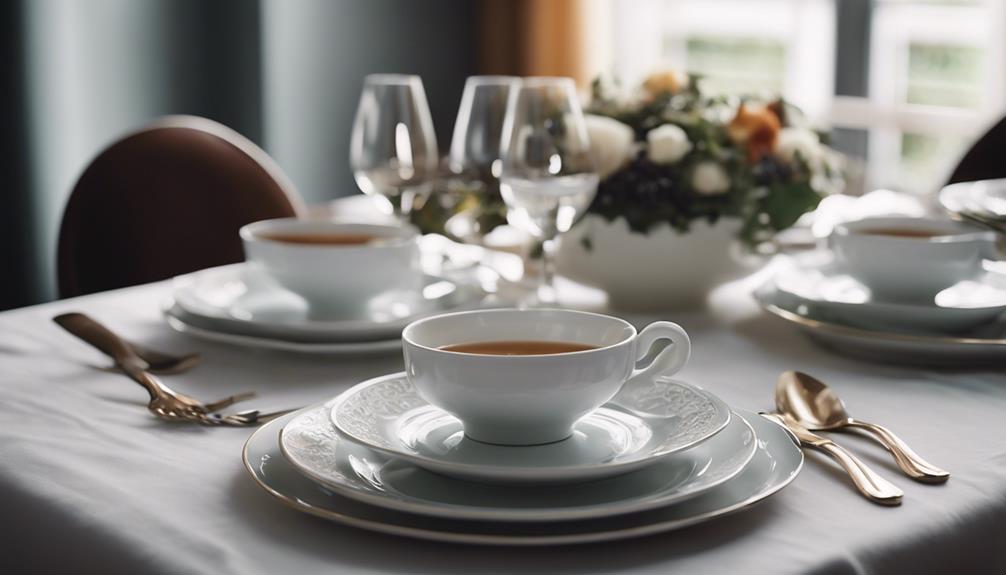
Exuding elegance and durability, porcelain tableware serves a versatile purpose, suitable for both everyday meals and formal gatherings alike. Porcelain, known for being high fired, is crafted at intense temperatures, resulting in its exceptional durability and luxurious finish. This makes it ideal for various occasions, from casual dinners to upscale events. Its chip-resistant nature guarantees longevity, whether you use it daily or sparingly for special celebrations. The non-porous and stain-resistant qualities of porcelain tableware mean it maintains its pristine appearance even after repeated use, adding a touch of sophistication to your table setting.
Many choose porcelain tableware for its ability to elevate dining experiences, thanks to its refined quality and high-end appearance. The use of bone ash in bone china porcelain further enhances its strength and bright white color, making it perfect for elegant dining affairs. Whether you're enjoying a simple breakfast or hosting an elaborate dinner party, porcelain tableware effortlessly blends practicality with style, making it a timeless choice for any occasion.
Popular Brands of Porcelain Tableware
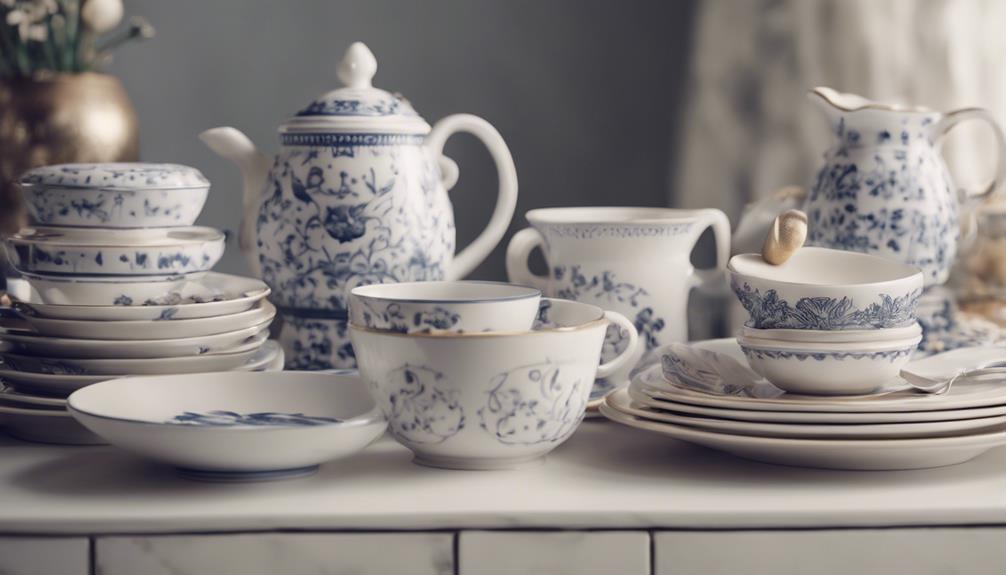
Renowned for their quality and elegance, popular brands of porcelain tableware include Limoges, Michael Aram, Meissen, Bernardaud, and Wedgwood.
Limoges porcelain stands out for its high-quality and dazzling white hues, making it a luxurious choice for exquisite table settings. Michael Aram uses Limoges clay to craft their tableware, ensuring exceptional quality and elegance in every piece.
Meissen porcelain, originating from Germany, is celebrated for its historic roots and hand-painted designs that add a touch of sophistication to any dining experience. Bernardaud, a prestigious French brand, offers fine porcelain tableware with intricate patterns and luxurious finishes, perfect for those seeking a blend of tradition and opulence.
Wedgwood, the classic English brand, produces timeless and sophisticated porcelain tableware appreciated for its traditional elegance that never goes out of style. Each of these brands brings a unique blend of craftsmanship and beauty to the world of porcelain tableware.
Frequently Asked Questions
What Is the Difference Between Ceramic and Porcelain Tableware?
When it comes to ceramic vs. porcelain tableware, the key differences lie in durability and water absorption. Porcelain is tougher, less likely to chip, and absorbs less water due to its non-porous nature.
Ceramic, on the other hand, is more porous, making it more prone to breakage and water retention. Consider your priorities for longevity and aesthetics to choose between these options for your table setting needs.
Is Porcelain Tableware Good?
Porcelain tableware isn't just excellent; it's exceptional! Its durability and resistance to chipping make it perfect for everyday meals or fancy dinners.
The non-porous quality keeps stains at bay and helps maintain food warmth. With its elegant appearance and bright white color, porcelain tableware adds a touch of sophistication to any occasion.
Plus, it's dishwasher safe, making cleanup a breeze. So yes, porcelain tableware is definitely a first-rate choice!
How to Tell if a Plate Is Porcelain?
To tell if a plate is porcelain, look for translucency, thinness, and light weight compared to ceramic. Porcelain is non-porous and stain-resistant, ideal for formal dining.
High-quality porcelain often comes from Limoges, France, known for its dazzling white hues.
When tapped, porcelain emits a distinct sound due to its density and quality. These characteristics help you identify if a plate is made of porcelain.
Which Is Better, Stoneware or Porcelain?
When choosing between stoneware and porcelain, consider your needs. Porcelain is elegant and durable, great for special occasions. Stoneware is more casual and less sturdy but perfect for everyday use.
If you prioritize elegance and durability, go for porcelain. For a laid-back vibe with a touch of charm, stoneware is your pick.
Think about your lifestyle and preferences to make the best choice between the two.
Conclusion
To sum up, it's noteworthy that porcelain tableware is a versatile and elegant option for dining and entertaining. With its durability, heat resistance, and timeless beauty, porcelain tableware is a popular choice for many households.
Surprisingly, according to a recent study, porcelain tableware is preferred by 63% of consumers for special occasions due to its luxurious appearance and ability to elevate any dining experience.
Choose porcelain tableware for a touch of sophistication in your home.
